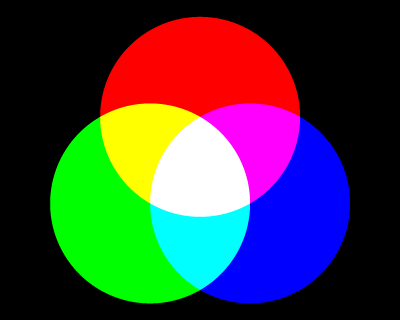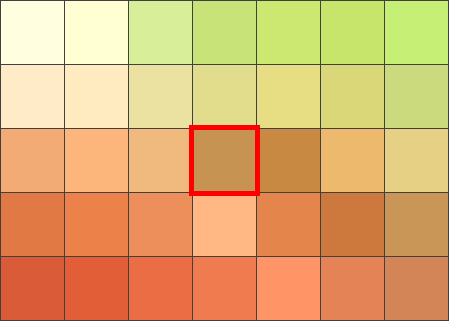2017.03.01
2025.03.06
ステンドグラス風画像
はじめに



具体的には、画像の全ての座標(x,y)から、選択した複数のピクセル(コア)の中で一番近いものを見つけ、そのピクセルの色を座標(x,y)に格納していきます。この処理により、コアを中心とした幾何学模様の色の塗り潰しができ、それがステンドグラスのパーツのように見えます。
Javaソースコード
これを、Javaソースコードにすると以下のようになります。
StainedGlass.java
001 002 003 004 005 006 007 008 009 010 011 012 013 014 015 016 017 018 019 020 021 022 023 024 025 026 027 028 029 030 031 032 033 034 035 036 037 038 039 040 041 042 043 044 045 046 047 048 049 050 051 052 053 054 055 056 057 058 059 060 061 062 063 064 065 066 067 068 069 070 071 072 073 074 075 076 077 078 079 080 081 082 083 084 085 086 087 088 089 090 091 092 093 094 095 096 097 098 099 100 101 102 103 104 105 106 107 108 109 110 111 112 113 114 115 116 117 118 119 120 121 122 123
import java.awt.image.BufferedImage; import java.io.File; import javax.imageio.ImageIO; import java.io.IOException; // コアの座標と色を格納するクラス class CoreColor { public int x, y; public int color; } public class StainedGlass { public static void main( String[] args ) { boolean result; // 結果格納フラグ int corenum; // コアの数 // ファイル名 String inname, outname; // 画像格納クラス BufferedImage img = null; // 入力した引数が3つ以上かを調べる if ( 3 > args.length ) { // 入力した引数が3つ未満の場合、使用方法を表示する System.out.println( "StainedGlass [入力JPEG名] [出力JPEG名] [コアの数]" ); return; } // 入力JPEG名をinnameに代入(拡張子".jpg"省略なし) inname = args[ 0 ]; // 出力JPEG名をoutnameに代入(拡張子".jpg"省略なし) outname = args[ 1 ]; // 引数を変換し、コア数に代入 try { corenum = Integer.valueOf( args[ 2 ] ); if ( 2 > corenum ) { System.out.println( "コア数に2以上を指定してください" ); return; } } catch( NumberFormatException ne ) { System.out.println( "引数が不正です" ); return; } // JPEGの読み込み try { // inname(入力JPEG)を読み込んでimgにセット img = ImageIO.read( new File( inname ) ); } catch (Exception e) { // inname(入力JPEG)の読み込みに失敗したときの処理 e.printStackTrace(); return; } // 画像の色の持ち方をチェック if ( BufferedImage.TYPE_3BYTE_BGR != img.getType() ) { System.out.println( "対応していないカラーモデルです!(" + inname +")" ); return; } // ステンドグラス画像の作成 int x, y; int width, height; // 画像サイズの取得 width = img.getWidth(); height= img.getHeight(); // コアを乱数で決める CoreColor core[] = new CoreColor[ corenum ]; for ( int i = 0; i < corenum; ++ i ) { // 乱数を発生し、適当に座標を求める core[ i ] = new CoreColor(); core[ i ].x = (int)( Math.random() * (double)width ); core[ i ].y = (int)( Math.random() * (double)height ); core[ i ].color = img.getRGB( core[ i ].x, core[ i ].y ); } // 全ての画素の座標(x,y)から最も近いコアを求め // そのコアの色を(x,y)に置く for ( y = 0; y < height; ++ y ) { for ( x = 0; x < width; ++ x ) { int minl = 10000000; int newcolor = 0; // 一番近いコアを求める for ( int i = 0; i < corenum; ++ i ) { // 距離の2乗を計算 int dx = core[ i ].x - x; int dy = core[ i ].y - y; int l = dx * dx + dy * dy; if ( l < minl ) { minl = l; newcolor = core[ i ].color; } } img.setRGB( x, y, newcolor ); } } try { // imgをoutname(出力JPEG)に保存 result = ImageIO.write( img, "jpeg", new File( outname ) ); } catch ( Exception e ) { // outname(出力JPEG)の保存に失敗したときの処理 e.printStackTrace(); return; } // 正常に終了 System.out.println( "正常に終了しました" ); } }
コンパイル ソースコードが「ANSI」の場合
C:\talavax\javasample>javac -encoding sjis StainedGlass.java
コンパイル ソースコードが「UTF-8」の場合
C:\talavax\javasample>javac StainedGlass.java
実行
C:\talavax\javasample>java StainedGlass sampleimage004_400x300.jpg stainedglass-100.jpg 100
・元の画像(sampleimage004_400x300.jpg)
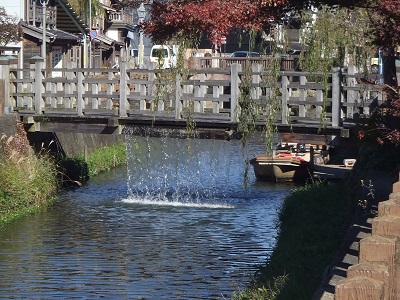
・コア数=100で作成した画像(stainedglass-100.jpg)
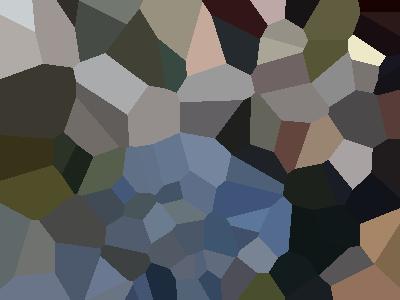
・コア数=500で作成した画像(stainedglass-500.jpg)
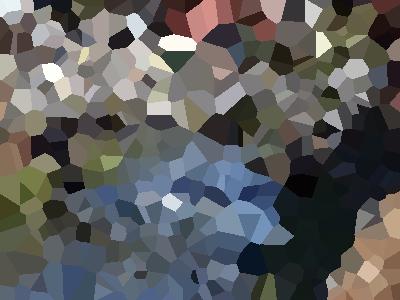
・コア数=1000で作成した画像(stainedglass-1000.jpg)
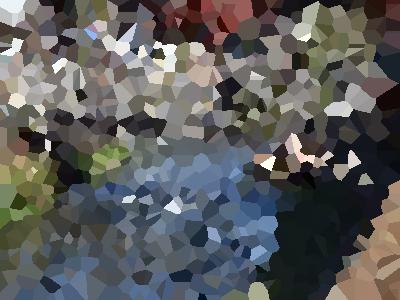
・コア数=5000で作成した画像(stainedglass-5000.jpg)
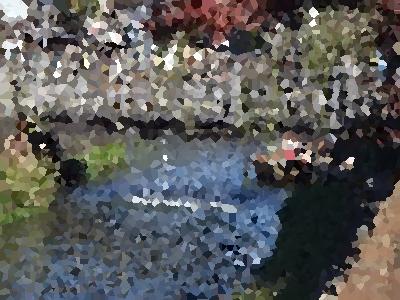
・コア数=10000で作成した画像(stainedglass-10000.jpg)
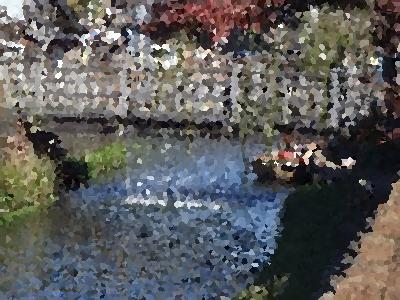
・コア数=50000で作成した画像(stainedglass-50000.jpg)

Javaソースコードの解説
ここからは、このJavaソースコードを上から順番に解説していきます。
001 002 003 004
import java.awt.image.BufferedImage; import java.io.File; import javax.imageio.ImageIO; import java.io.IOException;
Javaのクラスライブラリの中から「java.awt.image.BufferedImage」と「java.io.File」と「javax.imageio.ImageIO」と「java.io.IOException」と「java.awt.image.RasterFormatException」というパッケージにあるクラスを、このプログラム内で使うために記述します。 この記述により、ImageIOクラスとBufferedImageクラスとRasterFormatExceptionが利用できるようになります。
007 008 009 010 011
// コアの座標と色を格納するクラス class CoreColor { public int x, y; public int color; }
014
public class StainedGlass {
クラス名を、StainedGlassとしています。
015
public static void main( String[] args ) {
016 017 018 019 020 021 022
boolean result; // 結果格納フラグ int corenum; // コアの数 // ファイル名 String inname, outname; // 画像格納クラス BufferedImage img = null;
024 025 026 027 028 029 030
// 入力した引数が3つ以上かを調べる if ( 3 > args.length ) { // 入力した引数が3つ未満の場合、使用方法を表示する System.out.println( "StainedGlass [入力JPEG名] [出力JPEG名] [コアの数]" ); return; }
032 033 034 035 036 037 038 039 040 041 042 043 044 045 046 047 048 049
// 入力JPEG名をinnameに代入(拡張子".jpg"省略なし) inname = args[ 0 ]; // 出力JPEG名をoutnameに代入(拡張子".jpg"省略なし) outname = args[ 1 ]; // 引数を変換し、コア数に代入 try { corenum = Integer.valueOf( args[ 2 ] ); if ( 2 > corenum ) { System.out.println( "コア数に2以上を指定してください" ); return; } } catch( NumberFormatException ne ) { System.out.println( "引数が不正です" ); return; }
与えられた引数をそれぞれ、入力JPEGファイル名、出力JPEGファイル名、コアの数を格納する変数に代入しています。指定したコアの数が2未満の場合、return文によってmainメソッドを抜けています。
051 052 053 054 055 056 057 058 059
// JPEGの読み込み try { // inname(入力JPEG)を読み込んでimgにセット img = ImageIO.read( new File( inname ) ); } catch (Exception e) { // inname(入力JPEG)の読み込みに失敗したときの処理 e.printStackTrace(); return; }
ImageIO.readメソッド
public static BufferedImage read( File input ) throws IOException
・Fileオブジェクトを復元した結果をBufferedImageに格納します。 パラメータ input : Fileオブジェクト 戻り値 inputを復元したBufferedImageaを返します。
try { ~ } catchは、失敗する可能性がある処理を波括弧で囲み、その処理に失敗したときにcatch { ~ }の波括弧で囲まれた処理を実行するということです。この場合は、JPEGファイル名が不正であったり、存在していなかったり、フォーマットが違っているなどが原因で処理が失敗する可能性があります。処理が失敗するとreturn文によってmainメソッドを抜けるようにしています。
061 062 063 064 065 066 067
// 画像の色の持ち方をチェック if ( BufferedImage.TYPE_3BYTE_BGR != img.getType() ) { System.out.println( "対応していないカラーモデルです!(" + inname +")" ); return; }
BufferedImage.getTypeメソッド
public static int getType()
・イメージ型を返します。 パラメータ なし 戻り値 BufferedImage のイメージ型を返します。
069 070 071
// ステンドグラス画像の作成 int x, y; int width, height;
ステンドグラス作成処理で使う変数を宣言しています。
073 074 075
// 画像サイズの取得
width = img.getWidth();
height= img.getHeight();
077 078 079 080 081 082 083 084 085
// コアを乱数で決める CoreColor core[] = new CoreColor[ corenum ]; for ( int i = 0; i < corenum; ++ i ) { // 乱数を発生し、適当に座標を求める core[ i ] = new CoreColor(); core[ i ].x = (int)( Math.random() * (double)width ); core[ i ].y = (int)( Math.random() * (double)height ); core[ i ].color = img.getRGB( core[ i ].x, core[ i ].y ); }
CoreColorクラスの配列coreを用意し、その中に乱数で作成した画像の座標(x,y)とその位置の色を格納しています。コア数が多くなるほど、同じ座標をcore配列に入れる確率が高くなりますが、本プログラムでは同じ座標でもそのまま格納しています。例えば、指定したコア数が3で、そのうち2つが同じ座標であった場合には、作成された画像のコアが2つしかないように見えます。
090 091
for ( y = 0; y < height; ++ y ) { for ( x = 0; x < width; ++ x ) {
092 093 094 095 096 097 098 099 100 101 102 103 104 105 106
int minl = 10000000; int newcolor = 0; // 一番近いコアを求める for ( int i = 0; i < corenum; ++ i ) { // 距離の2乗を計算 int dx = core[ i ].x - x; int dy = core[ i ].y - y; int l = dx * dx + dy * dy; if ( l < minl ) { minl = l; newcolor = core[ i ].color; } }
ピクセル座標(x,y)から一番近いコアの座標を求めています。求めた結果、そのコアの色をnewcolorに格納しています。本プログラムでは(x,y)からコアの座標までの距離をピタゴラスの定理を使って計算していますが、距離の比較には、距離の2乗を使っています。2点間の距離を計算するには以下の図のように、xとyの変化量dxとdyの2乗の和をとって、その平方根を計算する必要があります。ただし、この処理の場合は実際の距離は使用する必要がなく、距離の比較が出来ればよいので平方根の計算は省略して距離の2乗で比較しています。これにより、少しでも処理時間を短くしようとしています。
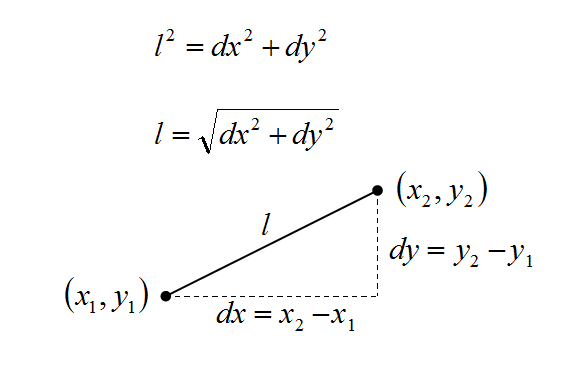
107
img.setRGB( x, y, newcolor );
111 112 113 114 115 116 117 118
try { // imgをoutname(出力JPEG)に保存 result = ImageIO.write( img, "jpeg", new File( outname ) ); } catch ( Exception e ) { // outname(出力JPEG)の保存に失敗したときの処理 e.printStackTrace(); return; }
BufferedImageクラスのnewimgのメモリ内のデータを、出力JPEG名の変数(outname)に格納されているファイル名で保存します。この場合は、JPEGファイル名が不正であったり、保存先のHDDなどが存在していなかったり、空き容量が少ないなどが原因で処理が失敗する可能性があります。
ImageIO.wrireメソッド
public static boolean write( RenderedImage im, String formatName, File output ) throws IOException
・BufferedImageを画像ファイルに保存します。
パラメータ RenderedImage : 保存するRenderedImage
formatName : 画像ファイルのフォーマット(png/jpeg/bmp/gifなど)
output : Fileオブジェクト
戻り値 保存に成功するとtrue、失敗するとfalseを返します。
120 121
// 正常に終了 System.out.println( "正常に終了しました" );
全ての処理が正常終了すると、ここまで処理が実行されます。
以上です。
関連コンテンツ
一般に使われている画像フォーマットには、いろいろな種類があります。画像フォーマットBMP、JPEG、PNG、GIF、TIFFの特徴を知ってますか?



